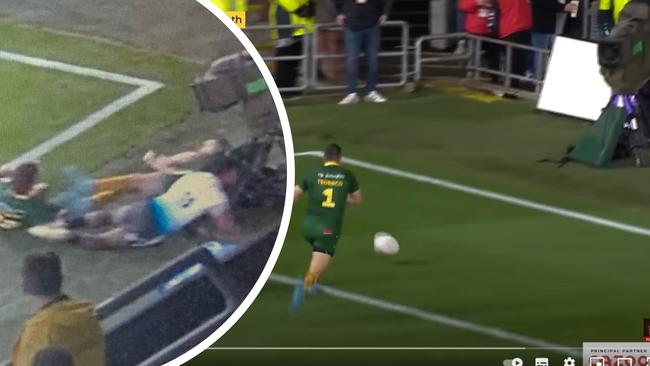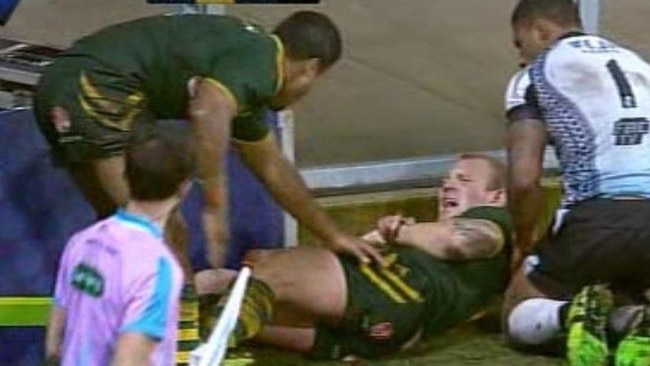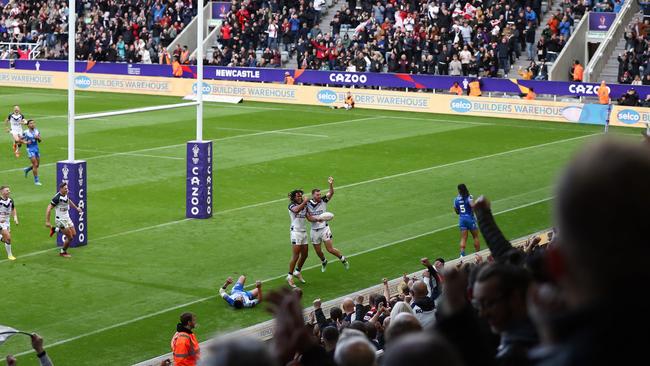RLWC could face million dollar litigation as star players crash into fences and television cameras
Clubs and legal experts reveal major concerns over long-term player injuries – and possible litigation – by playing matches on smaller English playing fields

NRL
Don't miss out on the headlines from NRL. Followed categories will be added to My News.
NRL clubs and Australian law experts have revealed increasing concerns over long-term injuries – and possible litigation – by playing World Cup matches on smaller fields in England.
And it could cost tournament organisers more than $1m.
Kangaroos superstar James Tedesco collided heavily with a television camera, positioned behind the in-goal area, during Australia’s opening round match against Fiji in Hull.
Players have privately expressed dismay over the limited space between sidelines and dead ball lines with cameras and advertising hoarding at the compact and slippery English grounds.

“The players at the World Cup are like thoroughbreds. It would be the equivalent of having a concrete barrier two metres past the finish post at Randwick. The loss of earnings and potential earnings could amount to (litigation worth) more than $1m,” said Sydney solicitor, Paul McGirr.
Tedesco crashed into a BBC broadcast camera when trying to prevent Fiji from scoring the match’s opening try.
He avoided injury but Kangaroos officials and players are on alert while legal eagles also warning of potential action if injuries occur through shortened playing surfaces.

During the 2013 World Cup in England, Australian players Luke Lewis and Brett Morris sustained injuries by sliding into stadium fences.
Lewis dislocated his left shoulder in a game against Fiji at St Helens and missed the opening 14 weeks for Cronulla the following season. Morris hurt himself in the final against New Zealand at Old Trafford.
“It’s the great elephant in the room which is being ignored with the attitude of: ‘it will be right’. Whoever is hosting the tournament is opening themselves up to the real potential of litigation if someone suffers a serious injury which prematurely ends their career,” McGirr said.
“The in-goals are so ridiculous that even if someone isn’t sliding for a try or tackle, they are still at risk of colliding with cameras and or the fence.
“It’s an obvious problem that is being ignored and no-one wants to address it because it would mean possibly moving games from those stadiums.
“I’m surprised there hasn’t been any injuries to date but certainly if there were, the stadiums and the game owe a duty of care, particularly given it’s a collision sport where the aim of the game is to knock somebody off balance.
“They want to host these games at these particular stadiums that aren’t originally designed for rugby league. I know Cricket Australia in the 1990s had to change their fields with ropes for exactly the same problem.”

Locals suggest some stadiums being used for the World Cup were built primarily for football, meaning the playing surface areas are short at both ends. Others claim England traditionally has smaller in-goal areas.
“We are definitely mindful of it when watching the games and would hate to see a player be injured and be out for a period of time,” said Raiders CEO, Don Furner.
“It has always been the case over there. Their dead ball areas are tiny. You would think they would have padding right around that area.”
Brydens Lawyers principal Lee Hagipantelis also spoke of possible litigation.
“The suffering of an injury in itself does not entitle anyone to make a claim for compensation,” he told SEN. “You have to look at the circumstances of the injury and (ask) has there been any failing or negligence or failing on the part of the event organisers.
“I think they are running a seriously, seriously high risk of some litigation being brought if a player does suffer an injury of that kind, given that it has to be foreseeable that it can occur.
“The proximity of the players and the playing of the game to the surroundings is of a kind that it would have to be foreseeable a player could slide into a fence or a cameraman and suffer serious injury.”
More Coverage
Originally published as RLWC could face million dollar litigation as star players crash into fences and television cameras





